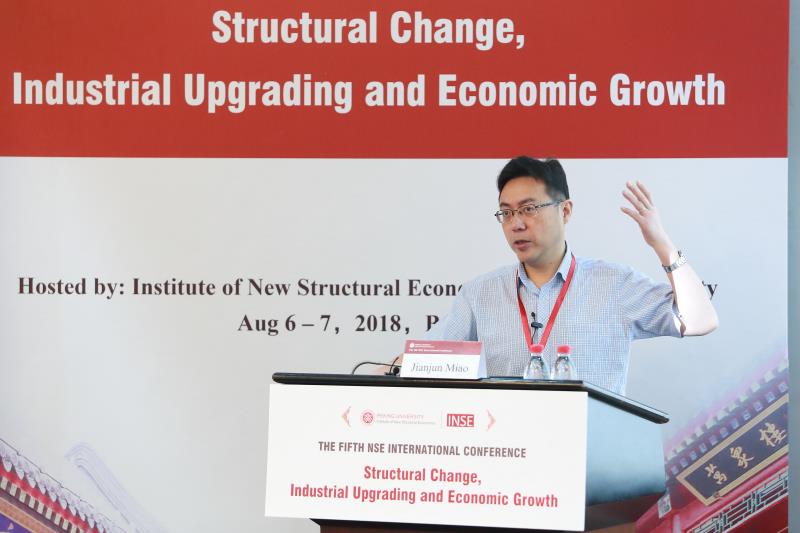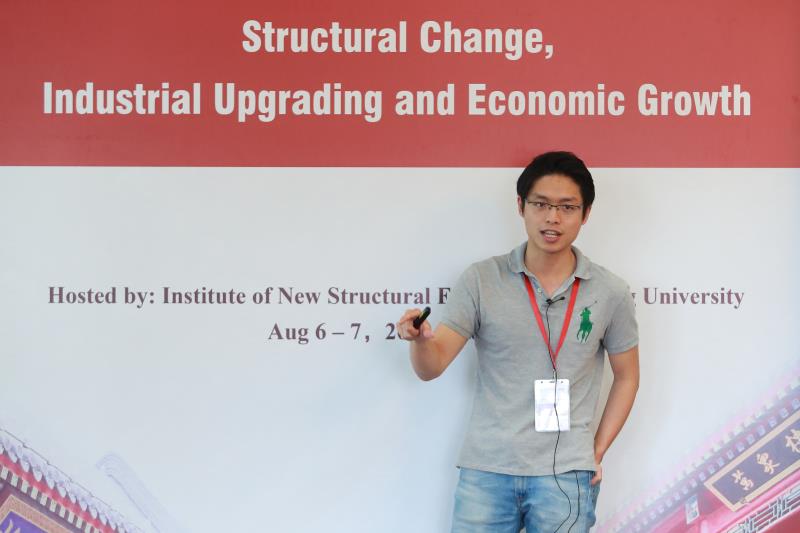Research﹀
The 5th NSE International Conference Brief Ⅲ
2018-08-10
Content introduction:
Conference Brief 3

Jianjun Miao:
Convergence, Financial Development and Policy Analysis
On the morning of August 7, Professor Jianjun Miao from Boston University delivered a speech entitled “Convergence, Financial Development and Policy Analysis”, presenting his recent work co-authored with Professor Justion Yifu Lin, Dean of the Institute of New Structural Economics, and Professor Pengfei Wang from Hong Kong University of Science and Technology.
Professor Miao’s research attempts to integrate financial development, economic growth and inflation to explain why some developing countries have realized convergence but others have not. The authors used an overlapping generation (OLG) framework with credit constraints, and based on the Aghion, Howitt, and Mayer-Foulkes (1995) model, introduced currency utility, individual heterogeneity (savers and entrepreneurs), and savers’ risk aversion. The results show that in the competitive equilibrium, if there is no credit constraint, the economy can reach the growth rate of the world frontier, but if there is credit constraint, the growth rate will be subject to the degree of credit constraint or even fall into a poverty trap.
Further, the authors gave the efficient allocation by solving social planner’s problem and then analyzed the causes the inefficiency: monopoly in the production of intermediate products, externalities of innovation, imperfect in credit markets, and the inefficiency of the OLG model itself. Finally, the authors proposed that a particular combination of monetary and fiscal policies can make the competitive equilibrium attain the efficient allocation.

Ruochen Dai:
Community Networks and the Growth of Private Enterprise in China
The growth of private enterprise plays an important role in China’s industrialization. However, without effective legal systems or well functioning financial institutions, precisely what elements are involved in promoting the growth of China’s entrepreneurs is still unclear. In the lecture, Professor Ruochen Dai focuses on the Chinese social networks and point out that the social networks (or guanxi) in China is a critical factor that facilitates the growth of private enterprise in China. The analysis plan of the study is shown as follows.
In the first step, Professor Ruochen Dai argue that population density is a good proxy for social connectedness in a county. Intuitively, business networks drawn from higher population density counties will sustain higher levels of mutual help - are of higher quality - regardless of where they are located. And this argument is empirically validated with data from China Family Panel Survey.
The second step of the analysis plan is the establishment of the theoretical model that describes the relationship between network quality and the dynamics of entry, concentration and firm size. The theoretical model primarily consists of two parts: the dynamics of entry and concentration and the firm size dynamics. The main conclusion in this step includes the positive correlation between the level of social connectedness and the entry and concentration at any given time and the negative correlation between the level of social connectedness and the initial capital and ability of marginal entrants.
Finally, the empirical evidence and counter-factual simulation is given using the SAIC registration database to test the preceding arguments and to study the effect of Interest rate subsidy on profits. Thus, Professor Ruochen Dai eventually draws to the conclusion that small firms and wide dispersion in firm size and productivity in the analysis are consequences of networks that substitute for missing markets, rather than inefficient taxes or regulations and subsidies should account for intra-community spillovers.

Jingting Fan:
Talent, Geography, and Offshore R&D
In the last lecture on the morning of August 7, Professor Jingting Fan delivered a speech titled “Talent, Geography, and Offshore R&D”. In today’s world of globalization, more and more studies focus on the costs and benefits of the trade and the offshore production of multinational firms, but the offshore R&D of multinational firms is overlooked. In todays lecture, therefore, Professor Jingting Fan emphasizes the importance of offshore R&D in the globalization and briefly introduces his research on this topic. The contest of the speech primarily consists of 4 parts: the measurement of offshore R&D level, the theoretical model, quantification and the conclusion.
The level of offshore R&D level is defined by the fraction of R&D in host country by affiliates of foreign corporations. Later, Professor Jingting Fan describes the the theoretical model in his research. In the model, firms match with heterogeneous researchers to develop new product blueprints, and then engage in offshore production and exporting. Cross-country differences in the distributions of firm managerial efficiency and researcher talent generate a “talent-acquisition” motive for offshore R&D, while the frictions impeding offshore production and trade lead to a “market-access” motive.
Professor Jingting Fan then provides empirical support for both motives using firm-level patenting data and finds additional evidence for these motives via counterfactuals using the calibrated model: international differences in endowment distributions and the market access motive collectively account for 90% of the average observed level of offshore R&D. Offshore R&D increases countries’ gains from global integration by a factor of 1.2 on average, with much larger increases for developing than for developed countries.
Written by: Yangtian Jiang
Proofread by: Prof. Lijun Zhu

